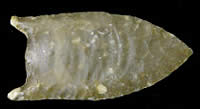
"I was stunned by the beauty of the workmanship.
The hair on the nape of my neck bristled erect. I had
never seen anything like it, and instinctively knew
it was special."
—Gene Mear, on finding a 12,000-year-old fluted
Folsom point while screening backdirt at Kincaid Shelter
in the late 1940s.
From "All Things Considered, It was Fun While It
Lasted," a small volume in which Mear recounts, among
other experiences, how his work at the site changed
the direction of his life from studies in chemistry
to a career in geology.
|

Gene Mear looks over a trench dug
through the shelter by the TMM . The young college student's
discovery of three Folsom points in the shelter is what
triggered the chain of events leading to systematic
investigations of the site. Photo by Glen Evans.
|
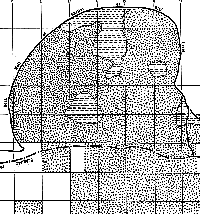
Map of TMM excavated units (marked
with dots) and location of treasure-hunters' pits (denoted
with horizontal lines) in Kincaid Shelter, as drawn
by Glen Evans. Click to enlarge and read key.
|
|
Only a small area of the surface deposit within
the shelter remained undisturbed, but fortunately there
had been comparatively little disturbance in the deeper
zones and in front of the shelter.
|

A crew member holds a screen over a wheelbarrow in front of the shelter where it will be filled with
another load of dirt. All sediments from the shelter
were screened for artifacts and then hauled to a dump
site below. TARL archives. Click to see full image.
|

Visitors pose in front of the field
camp tents with crew member Powell Goodwin, right, during
the 1948 investigations at the site. TARL archives.
|

Hard day at the shelter. University
of Texas field school students take a break from excavations
during the 1953 project at Kincaid. The woman sporting
the horned-rimmed glasses, in center, is Dee Ann Suhm,
who went on to become a professor at UT-Austin, director
of TARL, and author of numerous landmark publications
on Texas archeology.
|
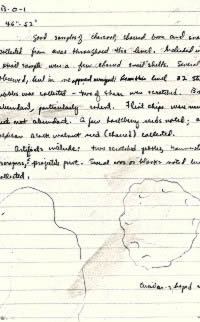
A page of field notes written by then-student Dee Ann Suhm at the U. T. field school at Kincaid in 1953. The young student's careful attention to detail was evident even then.
|
|
In December of 1947 while hunting on the Kincaid
Ranch, young college student Gene Mear and several of his
friends visited a rockshelter in a low, limestone bluff on
the Sabinal River. They examined some loosely piled-up dirt
that had been thrown out of a pit dug in the shelter fill
and found several flint artifacts and burned bone fragments.
His curiosity and latent geological instincts
aroused, Mear returned to the site several times, usually
accompanied by Kenneth Rochat, and screened quantities of
the loose, disturbed fill in the shelter. His labors paid
off: among the items he recovered was a complete, exquisitely
made Folsom point. "I was stunned by the beauty of the
workmanship. The hair on the back of my neck bristled erect.
I had never seen anything like it, and instinctively knew
it was something special."
After finding two additional Folsom points,
Mear reported his finds to Ellen Quillin, director of the
Witte Memorial Museum in San Antonio, and she, in turn, reported
the discovery to Glen Evans of the Texas Memorial Museum.
An experienced geologist who had also investigated
several important "early man" sites, Evans was excited
about the site's potential significance. Roughly 20 years
earlier in 1927 at Folsom, New Mexico, the same type of thin,
fluted projectile points had been discovered embedded in the
bones of extinct bison. Prior to that time, it was believed
that the first cultures in America were no more than several
thousand years old. The New Mexico discovery revolutionized
perceptions about the peopling of North America, pushing estimates
of the time of first migrations back into the Late Pleistocene.
In September 1948, Evans accompanied Mear to
Uvalde County to see the shelter, and the two cleaned off
a wall section of fill exposed in one of the old pits. The
shelter deposits were seen to be stratified (layered), with
bones of extinct animal species in place in the lower deposits
and cultural materials associated with bones of modern animals
in the upper layers. The possibility of gaining important
new information was obvious, and plans for excavation immediately
were initiated.
Controlled Excavations Begin
Excavation at the Kincaid site was done in two
stages. The first stage, in the fall of 1948, was sponsored
by the Texas Memorial Museum (TMM) and was directed by geologists
Sellards and Evans. During this first stage of excavation
most of the shelter deposits were removed down to the culturally
sterile fill near the bottom of the shelter, and deep trenches
dug in the terrace deposits in front of the shelter.
Before systematic investigations were underway,
Evans and the TMM crew evaluated the extent of disturbances
to the shelter fill. Several large pits had been dug inside
and near the shelter. In addition to the deepest of these
old pits and trenches, there were numerous smaller areas where
the fill had been dug into and otherwise disturbed. Only a
small area of the surface remained in its original position
but, fortunately, there had been somewhat less disturbance
in the deeper zones and in front of the shelter.
From people living in the area it was learned
that the pits and holes had been dug by "treasure hunters,"
men who were down on their luck and hoping for a change in
fortune. Hit hard by the Great Depression of the 1930s, they
hoped to find some of the legendary treasures described in
books by J. Frank Dobie and other authors.
Evaluating the damage, Evans saw that other
forces also had taken a toll on the shelter deposits. Small
rodents had burrowed into the shelter fill. There were also
larger burrows, probably made by badgers or coyotes digging
into the rodent dens. Some of the larger burrows had collapsed,
causing overlying deposits to be displaced. In some of the
open burrows, materials obviously belonging in the uppermost
layer had filtered down into lower layers or deposits. Roots
from brush and small trees growing on the slope in front of
the shelter had worked their way inside, causing considerable
disturbance, particularly in the upper two feet of deposits.
The first step for investigators was to remove
the old waste heaps and other disturbed materials in order
to minimize the danger of mixing artifacts and faunal remains
belonging in different stratigraphic layers, or zones. The
disturbed sediment was hauled out of the shelter in wheelbarrows
and passed through screens to salvage artifacts and bones.
The process of clearing out debris required more than two
weeks. After the debris had been removed from the shelter,
the entire surface of the undisturbed fill was painstakingly
swept clean with whisk brooms.
With a more-level floor in front of them, Evans
and his crew laid out a grid system made up of six-foot squares
across the undisturbed shelter fill. In order to be able to
study the stratigraphic relationships between deposits inside
and outside the shelter, they first dug contiguous rows of
successive squares to form long trenches, extending from the
back wall of the shelter. The two principal trenches thus
developed were between lines B-C and A-C, as shown on the
grid map above, left.
The crew then excavated the remaining squares
and plotted cross-section profiles. When possible, each square
was excavated in six-inch (15 cm) vertical cuts, or levels,
but thicker cuts were made at some places where large boulders,
tree roots, or burrows made the usual six-inch cuts impractical.
Excavated material was screened, typically through one-quarter
inch screens; artifacts were logged by provenience (location);
and sediments were hauled out of the shelter to a spoils dump
area.
The TMM crew succeeded in investigating and documenting
most of the shelter deposits, with the exception of several
units near the back where ancient travertine had hardened
and cemented the fill. The workers completely removed the
ancient stone pavement and excavated the underlying zones
to near bedrock in several areas. A section of fill near the
front of the shelter was left in place as a "witness
column" to preserve a record of the stratigraphy for
future investigators. Artifacts, animal bones, a sample of
paving stones, and field records were packed up and brought
back to Austin for analysis.
U.T. Students Join the Effort
Five years later, during the heat of summer,
the second stage of excavation got underway at Kincaid. Led
by anthropology professor T. N. Campbell, the effort was jointly
sponsored by the Texas Memorial Museum and the Department
of Anthropology of the University of Texas. Unlike the previous
work, the project was conducted as a summer field school to
train college students in archeological methods and techniques.
During the field school, the remainder of the
culture-bearing deposits of the shelter were removed, further
excavation was done in the terrace deposits in front of the
shelter, and five test excavations were made in the terrace
deposits under small bluff overhangs immediately east and
west of the main shelter.
Among the field school students was a young woman
destined to become a major figure in Texas archeology. Dee
Ann Suhm (later Story) received her basic training at Kincaid,
went on on to earn a Ph.D in anthropology, teach at the University
of Texas, and become the director of the Texas Archeological
Research Laboratory. Her field notes from Kincaid reflect,
even then, a careful eye for detail that she used effectively
in writing landmark publications such as An Introductory
Handbook to Texas Archeology, published in 1954 with Edward
Jelks and Alex Krieger.
Over the course of roughly four months of excavations during
the two field projects, a total of 55 squares were dug.
All collected artifacts were assigned numbers according
to their provenience, including a generic lot number to designate
materials found out of their original context. Evans estimates
that at least half of the artifacts were from the disturbed
fill, or backdirt scooped out and left in piles by the treasure
seekers.
A Voice from Beyond
While excavating the site in 1948, Evans remembers
having a brush with a furtive individual who, unbeknown to
the crew, was watching over the procedures.
He recalls: "I was digging a profile out
in front of the shelter when I heard a low voice saying, 'You're
diggin' in the wrong place.' It was one of the local people,
hidden in the brush—likely one of the people who had
dug at the site seeking treasure. But it was clear he wasn't
prepared to show me what he thought was the right place."
And of course, Evans notes, the true treasure
at Kincaid was very different than what the strange man was
after.
|
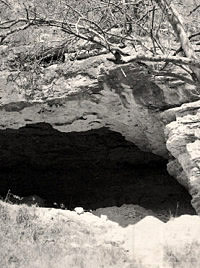
Backdirt piles left by treasure hunters
can be seen mounded in the front of the shelter (bottom
right ) after TMM investigators cleared away brush.
TARL archives. Click to see full image.
Click images to enlarge
|
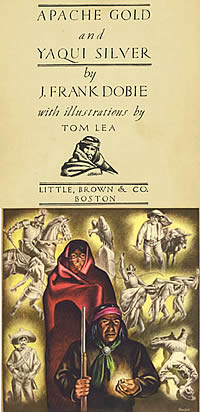
Books such as J. Frank Dobie's Apache
Gold and Yaqui Silver, published in 1939, inspired treasure
hunters to dig for legendary riches in area caves and
shelters such as Kincaid. Original Tom Lea cover art
and frontspiece courtesy of Mrs. Tom Lea and the University
of Texas Harry Ransom Center, Dobie Collection.
|

Work log and payroll (click to enlarge)
from Glen Evans' notes lists the small start-up crew
for the TMM project (including an individual named Woodrow
Wilson, presumably not related to the former U.S. president).
Paleontologist Grayson E. Meade was among those added
to the crew, and anthropologists Thomas N. Campbell,
Alex Krieger, and J. Charles Kelley were frequent visitors
to the site during TMM excavations. TARL archives.
|
|
Prior to the 1927 Folsom discovery in New Mexico,
it was believed that the first cultures in America were
no more than several thousand years old. That find revolutionized
perceptions about the peopling of North America, pushing
estimates of the time of first migrations back into
the Late Pleistocene.
|
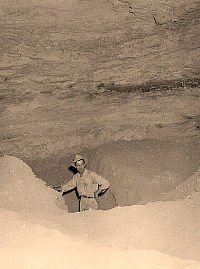
Geologist Glen Evans stands in one
of the large pits left by treasure hunters inside the
shelter. Evans directed Texas Memorial Museum field
work at the site. TARL archives. Click to see full image.
|
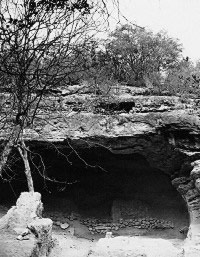
Stones from the pavement, shown lined
up across the front of the shelter, were removed after
documentation so that the investigators could excavate
the layers beneath them. The small tree at left marks
the location of the "witness column" left
in place by TMM crews to preserve a record of the stratigraphy.
TARL archives.
|
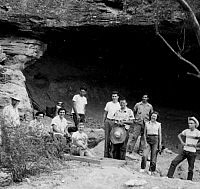
The University of Texas Field School
crew, headed by anthropology professor Thomas N. Campbell
(left), poses in front of the shelter before beginning
excavations in 1953. The field school dug the remaining
shelter fill and excavated sections of the terrace in
front of the shelter. TARL archives. Click for more
detail.
|
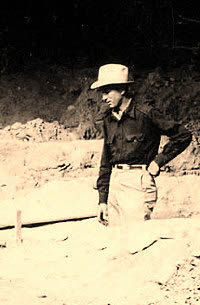
Glen Evans, shown in trench in front
of the shelter. One day while working, Evans heard a
voice from the underbrush nearby, telling him that he
was digging in the "wrong place." |
|